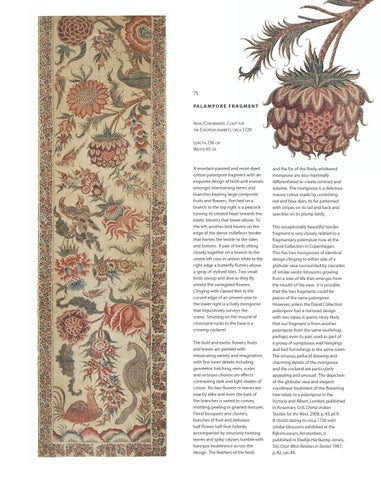75 PA L A M P O R E F R A G M E N T
INDIA (COROMANDEL COAST FOR THE EUROPEAN MARKET ), CIRCA 1720 LENGTH: 236 CM WIDTH: 65 CM
A mordant-painted and resist-dyed cotton palampore fragment with an exquisite design of birds and animals amongst intertwining stems and branches bearing large composite fruits and flowers. Perched on a branch to the top right is a peacock turning its crested head towards the exotic blooms that tower above. To the left, another bird hovers on the edge of the dense millefleurs border that frames the textile to the sides and bottom. A pair of birds sitting closely together on a branch to the centre left coos in unison while to the right edge a butterfly flutters above a spray of stylised lilies. Two small birds swoop and dive as they fly amidst the variegated flowers. Clinging with clawed feet to the curved edge of an unseen vase to the lower right is a lively mongoose that inquisitively surveys the scene. Strutting on the mound of chinoiserie rocks to the base is a crowing cockerel. The bold and exotic flowers, fruits and leaves are painted with intoxicating variety and imagination, with fine inner details including geometric hatching, veins, scales and virtuoso chiaroscuro effects contrasting dark and light shades of colour. No two flowers or leaves are exactly alike and even the bark of the branches is varied to convey mottling, peeling or gnarled textures. Floral bouquets and clusters, bunches of fruit and delicious half-flower half-fruit hybrids, accompanied by sinuously twisting leaves and spiky calyxes, tumble with baroque exuberance across the design. The feathers of the birds
and the fur of the finely whiskered mongoose are also maximally differentiated to create contrast and volume. The mongoose is a delicious mauve colour made by combining red and blue dyes, its fur patterned with stripes on its tail and back and speckles on its plump body. This exceptionally beautiful border fragment is very closely related to a fragmentary palampore now at the David Collection in Copenhagen. This has two mongooses of identical design clinging to either side of a globular vase surrounded by cascades of similar exotic blossoms growing from a tree-of-life that emerges from the mouth of the vase. It is possible that the two fragments could be pieces of the same palampore. However, unless the David Collection palampore had a mirrored design with two vases, it seems more likely that our fragment is from another palampore from the same workshop, perhaps even its pair, used as part of a group of sumptuous wall hangings and bed furnishings in the same room. The sinuous, pellucid drawing and charming details of the mongoose and the cockerel are particularly appealing and unusual. The depiction of the globular vase and elegant curvilinear treatment of the flowering tree relate to a palampore in the Victoria and Albert, London, published in Rosemary Crill, Chintz: Indian Textiles for the West, 2008, p. 43, pl. 9. A chintz dating to circa 1720 with similar blossoms exhibited at the Rijksmuseum, Amsterdam, is published in Ebeltje Hartkamp-Jonxis, Sits: Oost-West Relaties in Textiel, 1987, p. 82, cat. 49.
